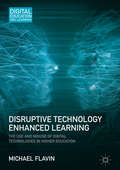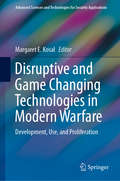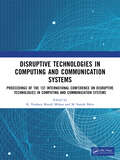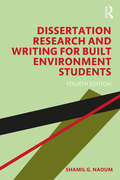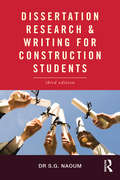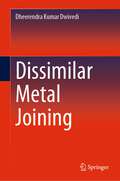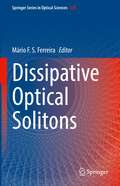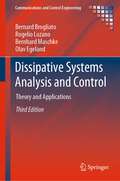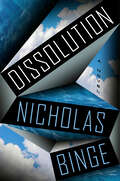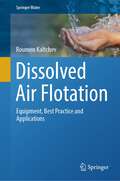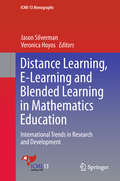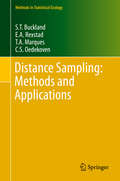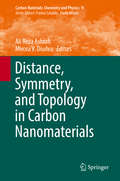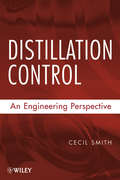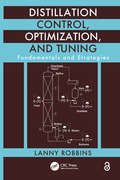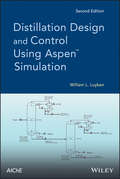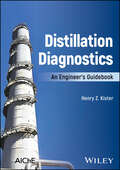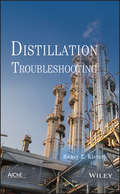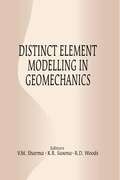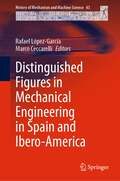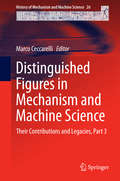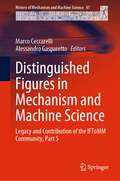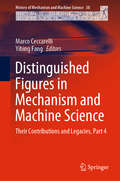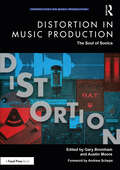- Table View
- List View
Disruptive Technology Enhanced Learning
by Michael FlavinThis book is about how technologies are used in practice to support learning and teaching in higher education. Despite digitization and e-learning becoming ever-increasingly popular in university teaching settings, this book convincingly argues instead in favour of simple and convenient technologies, thus disrupting traditional patterns of learning, teaching and assessment. Michael Flavin uses Disruptive Innovation theory, Activity Theory and the Community of Practice theory as lenses through which to examine technology enhanced learning. This book will be of great interest to all academics with teaching responsibilities, as it illuminates how technologies are used in practice, and is also highly relevant to postgraduate students and researchers in education and technology enhanced learning. It will be especially valuable to leaders and policy-makers in higher education, as it provides insights to inform decision-making on technology enhanced learning at both an institutional and sectoral level.
Disruptive and Game Changing Technologies in Modern Warfare: Development, Use, and Proliferation (Advanced Sciences and Technologies for Security Applications)
by Margaret E. KosalThis book explores and analyzes emerging innovations within today’s most cutting-edge science and technology (S&T) areas, which are cited as carrying the potential to revolutionize governmental structures, economies, and international security. Some have argued that such technologies will yield doomsday scenarios and that military applications of such technologies have even greater potential than nuclear weapons to radically change the balance of power. As the United States looks to the future – whether dominated by extremist groups co-opting advanced weapons in the world of globalized non-state actors or states engaged in persistent regional conflicts in areas of strategic interest – new adversaries and new science and technology will emerge. Choices made today that affect science and technology will impact how ably the US can and will respond. Chapters within the book look at the changing strategic environment in which security operations are planned and conducted; how these impact science and technology policy choices made today; and predictions of how science and technology may play a beneficial or deleterious role in the future. Some game changing technologies have received global attention, while others may be less well known; the new technologies discussed within this proposal, as well as future discoveries, may significantly alter military capabilities and may generate new threats against military and civilian sectors.
Disruptive technologies in Computing and Communication Systems: Proceedings of the 1st International Conference on Disruptive technologies in Computing and Communication Systems
by K. Venkata Murali Mohan M. Suresh BabuThe 1st International Conference on Disruptive Technologies in Computing and Communication Systems (ICDTCCS - 2023) has received overwhelming response on call for papers and over 119 papers from all over globe were received. We must appreciate the untiring contribution of the members of the organizing committee and Reviewers Board who worked hard to review the papers and finally a set of 69 technical papers were recommended for publication in the conference proceedings. We are grateful to the Chief Guest Prof Atul Negi, Dean – Hyderabad Central University, Guest of Honor Justice John S Spears -Professor University of West Los Angeles CA, and Keynote Speakers Prof A. Govardhan, Rector JNTU H, Prof A.V.Ramana Registrar – S.K.University, Dr Tara Bedi Trinity College Dublin, Prof C.R.Rao – Professor University of Hyderabad, Mr Peddigari Bala, Chief Innovation Officer TCS, for kindly accepting the invitation to deliver the valuable speech and keynote address in the same. We would like to convey our gratitude to Prof D. Asha Devi - SNIST, Dr B.Deevena Raju – ICFAI University, Dr Nekuri Naveen - HCU, Dr A.Mahesh Babu - KLH, Dr K.Hari Priya – Anurag University and Prof Kameswara Rao –SRK Bhimavaram for giving consent as session Chair. We are also thankful to our Chairman Sri Teegala Krishna Reddy, Secretary Dr. T.Harinath Reddy and Sri T. Amarnath Reddy for providing funds to organize the conference. We are also thankful to the contributors whose active interest and participation to ICDTCCS - 2023 has made the conference a glorious success. Finally, so many people have extended their helping hands in many ways for organizing the conference successfully. We are especially thankful to them.
Dissertation Research and Writing for Built Environment Students
by Shamil G. NaoumDissertation Research and Writing for Built Environment Students is a step-by-step guide to get students through their final year research project. Trusted and developed over three previous editions, the new fourth edition shows you how to select a dissertation topic, write a proposal, conduct a literature review, select the research approach, gather the data, analyse and present the information and ultimately produce a well-written dissertation. The book simplifies dissertation research and writing into a process involving a sequence of learnable activities and divides the process into three parts. Part One covers the necessary groundwork, including: identifying the problem, writing a proposal and reviewing the literature. Part Two covers the research design and includes: approaches and techniques for data collection and constructing and sampling a questionnaire. Part Three covers: measurement of data, analysis of data with SPSS, structuring and writing the whole dissertation, and supervision and assessment. This new edition is packed with updated examples and research samples, making this the ideal resource for students involved in research in built environment subjects such as construction management, construction project management, facilities management, real estate, building surveying, quantity surveying and civil engineering.
Dissertation Research and Writing for Construction Students
by S. G. NaoumUser-friendly, easy to dip into guide for all Built Environment students Takes the reader from the stage of choosing a topic to writing a well-structured dissertation Best case practice illustrated with numerous examples, case studies and references Dissertation Research and Writing for Construction Students covers topic selection, research planning, data collection and methodology, as well as structuring and writing the dissertation - in fact, everything needed for a successful write-up. A new section advising students on the use of the SPSS software 'Statistical Package for Social Sciences' will help readers make the best use of this tool. New examples and references ensure that this new edition of the bestselling construction dissertation guide is right up to speed with current practice. This is the ideal resource for students involved in research in Construction Management, Building and Quantity Surveying.
Dissimilar Metal Joining
by Dheerendra Kumar DwivediThis volume discusses dissimilar metal joining by fusion and solid-state processes. It is a complex process due to differences in chemical compositions, physical properties, mechanical properties, and thermal properties of the parent metals to be joined. The contents focus on issues related to fusion and solid-state welding of dissimilar metals. The book is based on the fundamental and experimental investigation on methodologies used to overcome issues related to dissimilar metal joining by fusion welding (GTAW and its variant), resistance spot welding and solid state joining (friction stir welding, friction stir spot welding, and diffusion bonding) largely based on research investigation conducted at Indian Institute of Technology (IIT) Roorkee.
Dissipative Optical Solitons (Springer Series in Optical Sciences #238)
by Mário F. S. FerreiraThis book introduces the basic concept of a dissipative soliton, before going to explore recent theoretical and experimental results for various classes of dissipative optical solitons, high-energy dissipative solitons and their applications, and mode-locked fiber lasers.A soliton is a concept which describes various physical phenomena ranging from solitary waves forming on water to ultrashort optical pulses propagating in an optical fiber. While solitons are usually attributed to integrability, in recent years the notion of a soliton has been extended to various systems which are not necessarily integrable. Until now, the main emphasis has been given to well-known conservative soliton systems, but new avenues of inquiry were opened when physicists realized that solitary waves did indeed exist in a wide range of non-integrable and non-conservative systems leading to the concept of so-called dissipative optical solitons. Dissipative optical solitons have many unique properties which differ from those of their conservative counterparts. For example, except for very few cases, they form zero-parameter families and their properties are completely determined by the external parameters of the optical system. They can exist indefinitely in time, as long as these parameters stay constant. These features of dissipative solitons are highly desirable for several applications, such as in-line regeneration of optical data streams and generation of stable trains of laser pulses by mode-locked cavities.
Dissipative Systems Analysis and Control: Theory and Applications (Communications and Control Engineering)
by Rogelio Lozano Bernard Brogliato Bernhard Maschke Olav EgelandThis second edition of Dissipative Systems Analysis and Control has been substantially reorganized to accommodate new material and enhance its pedagogical features. It examines linear and nonlinear systems with examples of both in each chapter. Also included are some infinite-dimensional and nonsmooth examples. Throughout, emphasis is placed on the use of the dissipative properties of a system for the design of stable feedback control laws.
Dissolution: A Novel
by Nicholas Binge&“Suspenseful, provocative and surprisingly tender.&”—NEW YORK TIMES BOOK REVIEW&“Cleverly weaves together time travel and memory games into a hard-to-put-down thriller. It&’s an expertly crafted puzzle of a story.&”—NEW SCIENTISTA woman dives into her husband's memories to uncover a decades-old feud threatening reality itself in this staggering technothriller from the bestselling author of AscensionMaggie Webb has lived the last decade caring for elderly husband, Stanley, as memory loss gradually erases all the beautiful moments they created together. It's the loneliest she's ever felt in her life. When a mysterious stranger named Hassan appears at her door, he reveals a shocking truth: Stanley isn't losing his memories. Someone is actively removing them to hide a long-buried secret from coming to light. If Maggie does what she's told, she can reverse it. She can get her husband back. Led by Hassan and his technological marvels, Maggie breaks into her husband's mind, probing the depths of his memories in an effort to save him. The deeper she dives, the more she unravels a mystery spanning continents and centuries, each layer more complex than the last. But Hassan cannot be trusted. Not just memories are disappearing, but pieces of reality itself. If Maggie cannot find out what Stanley did all those years ago, and what Hassan is after, she risks far more than her husband's life. The very course of human history hangs in the balance.
Dissolved Air Flotation: Equipment, Best Practice and Applications (Springer Water)
by Roumen KaltchevThis book provides an overview of the dissolved air flotation clarification technology. It brings together the three strands of knowledge and experience accumulated in this field - the analysis of the main phenomena involved and the interactions between them, the equipment for its implementation and its main applications in water treatment. The author draws attention to the design and operation of the different equipment used in practice, their advantages, and disadvantages in the different fields of application of this technology.The book is intended for:•Engineers and technicians working on the design of equipment and its integration into the overall water treatment plant as well as in the operation of flotation plants.•Consultants and engineering offices, hoping that it will help them to make the most appropriate choices regarding the applications of this process, as well as in the equipment selections.•Wastewater treatment plants operators, in the hope that it will help them to optimise the operation of their plants and improve their understanding and analysis of some problems they may encounter.•Purchasers and contractors, who have to make sometime difficult choices for reducing costs and, at the same time, ensure and guarantee the long-term performance and reliability of the plant.The book is oriented towards the practical side of implementing the technology. It contains a lot of information about the equipment (much more than in all other available publications on the same subject) as well as practical comments and recommendations that are very rarely found in this kind of book, written mostly by researchers. It will appeal to specialists who are comfortable with water chemistry, but it may also be of interest to water professionals who are more interested in the equipment, design and operation of water treatment plants.
Distance Learning, E-Learning and Blended Learning in Mathematics Education: International Trends in Research and Development (ICME-13 Monographs)
by Jason Silverman Veronica HoyosThis book builds on current and emerging research in distance learning, e-learning and blended learning. Specifically, it tests the boundaries of what is known by examining and discussing recent research and development in teaching and learning based on these modalities, with a focus on lifelong mathematics learning and teaching. The book is organized in four sections: The first section focuses on the incorporation of new technologies into mathematics classrooms through the construction or use of digital teaching and learning platforms. The second section presents a wide range of perspectives on the study and implementation of different tutoring systems and/or computer assisted math instruction. The third section presents four new innovations in mathematics learning and/or mathematics teacher education that involve the development of novel interfaces’ for communicating mathematical ideas and analyzing student thinking and student work. Finally, the fourth section presents the latest work on the construction and implementation of new MOOCs and rich media platforms developed to carry out specialized mathematics teacher education.
Distance Sampling: Methods and Applications
by S. T. Buckland E. A. Rexstad T. A. Marques C. S. OedekovenIn this book, the authors cover the basic methods and advances within distance sampling that are most valuable to practitioners and in ecology more broadly. This is the fourth book dedicated to distance sampling. In the decade since the last book published, there have been a number of new developments. The intervening years have also shown which advances are of most use. This self-contained book covers topics from the previous publications, while also including recent developments in method, software and application. Distance sampling refers to a suite of methods, including line and point transect sampling, in which animal density or abundance is estimated from a sample of distances to detected individuals. The book illustrates these methods through case studies; data sets and computer code are supplied to readers through the book's accompanying website. Some of the case studies use the software Distance, while others use R code. The book is in three parts. The first part addresses basic methods, the design of surveys, distance sampling experiments, field methods and data issues. The second part develops a range of modelling approaches for distance sampling data. The third part describes variations in the basic method; discusses special issues that arise when sampling different taxa (songbirds, seabirds, cetaceans, primates, ungulates, butterflies, and plants); considers advances to deal with failures of the key assumptions; and provides a check-list for those conducting surveys.
Distance, Symmetry, and Topology in Carbon Nanomaterials
by Ali Reza Ashrafi Mircea V. DiudeaThis contributed volume is inspired by the seminal discoveryand identification of C60. Starting with a comprehensive discussion featuringgraphene based nanostructures, subsequent chapters include topologicaldescriptions of matrices, polynomials and indices, and an extended analysis ofthe symmetry and topology of nanostructures. Carbon allotropes such as diamondand its connection to higher-dimensional spaces is explored along withimportant mathematical and topological considerations. Further topics coveredinclude spontaneous symmetry breaking in graphene, polyhedral carbonstructures, nanotube junction energetics, and cyclic polyines as relatives ofnanotubes and fullerenes. This book is aimed at researchers active in the studyof carbon materials science and technology.
Distillation Control
by Cecil L. SmithLearn to Design the Best Control Configuration for Any Distillation Column Today, distillation is by far the most common separation technique used in the chemical and petroleum industries. All distillation columns need to be carefully controlled in order to meet specified production and quality levels. Distillation Control enables readers to do this by approaching the subject from a process to develop, analyze, and troubleshoot all aspects of column controls. Readers are efficiency and effectiveness and minimizing coats. Distillation Control begins with a chapter dedicated to underlying principles, including separation processes, reflux and boilup ratios, and composition dynamics. Next, the author covers such critical topics as: Composition control Pressure control and condensers Reboilers and feed preheaters Application of feedforward Unit optimization Complex towers As readers progress through the text, they'll discover that the best control configuration for a distillation column is largely determined using steady-state process characteristics. The stage-by-stage separation models that the author sets forth for column design, therefore, provide information that is essential in developing the optimal control configuration. In addition to its clear explanations, Distillation Control is filled with clear diagrams and illustrations that clarify complex concepts and guide readers through multi-step procedures. Engineers as well as other professionals working in process facilities that use distillation to separate materials will fin that this book enables them to implement the latest tested and proven distillation control methods to meet their particular processing needs.
Distillation Control, Optimization, and Tuning: Fundamentals and Strategies
by Lanny RobbinsWith a focus on the fundamentals and strategies of distillation columns, this book covers the process variables for continuous distillation columns, as well as four basic control strategies and the typical cases in which they are used. The author defines the inlet and outlet streams and process variables for a distillation column and then explains the overall concept of the separation and purification that is performed. Performance and product quality are described in terms of specification requirements, and tools and techniques for the optimization of quality performance are provided. Figures and graphs are included within the reference to illustrate concepts.
Distillation Design and Control Using AspenTM Simulation
by William L. LuybenThe new edition of this book greatly updates and expands the previous edition. It boasts new chapters on the divided wall column and carbon dioxide capture from stack gas, revises the design and control of distillation systems, and explains the use of dynamic simulation to study safety issues in the event of operating failures. Using Aspen Plus to develop rigorous simulations of single distillation columns and sequences of columns, the book considers the economics of capital investment and energy costs to create an optimal system for separation methods in the chemical and petroleum industries.
Distillation Diagnostics: An Engineer's Guidebook
by Henry Z. KisterThorough guide on how to use various diagnostic techniques to troubleshoot problems in distillation columns Distillation Diagnostics familiarizes the reader with the multitude of tools available for diagnosing distillation and absorption tower problems and provides the reader with application guidelines derived from 40+ years of real-world experiences of the author. The book describes the capabilities, strengths and limitations of each tool, provides guidance on how to apply these tools to get the most insight and to test theories and ideas, shares the experience of how to correctly interpret the results provided by each technique, and guides the reader to a multitude of additional testing that they can perform to bring them closer to a correct diagnosis and an effective fix. Each technique is illustrated with real case studies and an extensive “dos and don’ts” list. Written by a global authority on distillation diagnostics and troubleshooting known as ‘The Tower Doctor’ by many in the field, Distillation Diagnostics includes information on: Possible solutions to the growing distillation failure rate despite the tremendous recent advances in distillation technologies Time-tested tools and techniques for correctly diagnosing distillation problems to provide simple low-cost fixes instead of unnecessary wasteful solutions, thus eliminating waste and dramatically reducing CAPEX, energy consumption and carbon footprint Combining the various diagnostic techniques to discard wrong theories and narrow in on the correct root cause and proper solution for various tower malfunctions Diagnosing flooding, foaming, plugging, weeping, maldistribution, channeling, distributor and collector overflows, low efficiencies, feeds and draws bottlenecks, assembly mishaps, tower internals damage, high base level issues, reactions in towers, contaminants, internal and external leaks, startup and/or shutdown difficulties Correctly interpreting gamma scan, thermal scan, and pressure drop data Getting the most out of testing techniques such as gamma scanning, neutron backscatter, wall temperature surveys, pressure drop measurements, column testing, sketching points of transition, collecting data for simulations, conducting mass and energy balances, analyzing operating charts, and in-situ water testing Turnaround tower inspections: what to look for Advanced gamma scanning and thermal scanning techniques and when to apply The “doctor and patient” troubleshooting strategy, which often constitutes the most effective, most systematic, and least expensive course of action Things to remember when formulating and testing theories, such as the balance between theory, data, the laws of physics, and chemistry Distillation Diagnostics is a timely, essential reference on the subject for plant managers and operators, production and startup supervisors, and chemical, process, and design engineers.
Distillation Troubleshooting
by Henry Z. KisterTHE FIRST BOOK OF ITS KIND ON DISTILLATION TECHNOLOGY The last half-century of research on distillation has tremendously improved our understanding and design of industrial distillation equipment and systems. High-speed computers have taken over the design, control, and operation of towers. Invention and innovation in tower internals have greatly enhanced tower capacity and efficiency. With all these advances, one would expect the failure rate in distillation towers to be on the decline. In fact, the opposite is the case: the tower failure rate is on the rise and accelerating. Distillation Troubleshooting collects invaluable hands-on experiences acquired in dealing with distillation and absorption malfunctions, making them readily accessible for those engaged in solving today's problems and avoiding tomorrow's. The first book of its kind on the distillation industry, the practical lessons it offers are a must for those seeking the elusive path to trouble-free distillation. Distillation Troubleshooting covers over 1,200 case histories of problems, diagnoses, solutions, and key lessons. Coverage includes: * Successful and unsuccessful struggles with plugging, fouling, and coking * Histories and prevention of tray, packing, and internals damage * Lessons taught by incidents and accidents during shutdowns, commissioning, and abnormal operation * Troubleshooting distillation simulations to match the real world * Making packing liquid distributors work * Plant bottlenecks from intermediate draws, chimney trays, and feed points * Histories of and key lessons from explosions and fires in distillation towers * Prevention of flaws that impair reboiler and condenser performance * Destabilization of tower control systems and how to correct it * Discoveries from shutdown inspections * Suppression of foam and accumulation incidents A unique resource for improving the foremost industrial separation process, Distillation Troubleshooting transforms decades of hands-on experiences into a handy reference for professionals and students involved in the operation, design, study, improvement, and management of large-scale distillation.
Distilled: A Natural History of Spirits
by Ian Tattersall Rob DeSalleAn imaginative natural history survey of the wide world of spirits, from whiskey and gin to grappa and moonshine In this follow-up book to A Natural History of Wine and A Natural History of Beer, authors Rob DeSalle and Ian Tattersall yet again use alcoholic beverages as a lens through which to gain a greater appreciation of natural history. This volume considers highly alcoholic spirits in the context of evolution, ecology, history, primatology, molecular biology, physiology, neurobiology, chemistry, and even astrophysics. With the help of illustrator Patricia Wynne, DeSalle and Tattersall address historical and cultural aspects and ingredients, the distillation process, and spirits and their effects. They also call on an international group of colleagues to contribute chapters on brandy, vodka, tequila, whiskies, gin, rum, eaux-de-vie, schnapps, baiju, grappa, ouzo, and cachaça. Covering beverages from across the globe and including descriptions of the experience of tasting each drink, this book offers an accessible and comprehensive exploration of the scientific dimensions of spirits.
Distinct Element Modelling in Geomechanics
by K.R. SaxenaLinear mathematical assumptions for procedures in other branches of engineering have little relevance for geoengineering, which must accommodate non-linear behaviors. Contributors to eight papers apply the breakthrough numerical modeling Distinct Element Method (Cundall, late 1960s). The design philosophy for structures or excavations in geotechnical engineering is different from that followed for fabricated materials like steel and concrete. The designer has little data both with regard to geological weaknesses and strength and deformation characteristics of materials before finalizing the designs. Also these characteristics vary from place to place. In-situ stresses due to gravity and tectonics and transient forces imposed due to rainfall and earthquakes make the matter more complicated. The pore waters carry the load initially before passing it on to the solids. For the analytical procedure, to be realistic, it should account for large displacements and non-linear behaviour including strain-softening. Because of these considerations, the designers have followed procedures based on simplifying assumptions such as linear, small strain, elastoplastic behaviour. Numerical procedures based on such assumptions, though very popular in other branches of engineering, have made little impact in geo-engineering. An attempt has been made in this book to compile the recent use of distinct element codes for solutions of some of the problems in geomechanics — particularly those involving excavations. It is hoped that it will provide an opportunity for the fraternity of geotechnical engineers to appreciate the opening of new frontiers in the use of computers for solving more challenging geotechnical problems.
Distinguished Figures in Mechanical Engineering in Spain and Ibero-America (History of Mechanism and Machine Science #43)
by Marco Ceccarelli Rafael López-GarcíaThis volume collects contributions on leading figures in mechanism and machine science (MMS) from Spain and Ibero-America over the last two centuries. The contributions examine scientists whose work resulted in relevant technical-scientific achievements, with an impact on technology and science in the historical evolution of MMS fields, and with an influence on the development of society at large. Biographical notes describing the efforts and achievements of these persons are included as well, but a technical survey is the core of each chapter, offering a modern interpretation of their legacy.
Distinguished Figures in Mechanism and Machine Science
by Marco CeccarelliThis is the second volume of a series of edited books whose aim is to collect contributed papers in a frame that can be a sort of dictionary of personalities in MMS (Mechanism and Machine Science). The papers will illustrate personalities by recognizing persons and their activity, by looking mainly at technical developments in the historical evolution of the fields that today are grouped in MMS. Thus, emphasis will be addressed also to biographical notes to describe efforts and experiences of people who have contributed to the technical achievements whose survey is the core of each contributed paper. It is a unique perspective for technical experts to go further in-depth into the historical background of their topics of expertise. This second volume of the dictionary project has been possible thanks to the invited authors who have enthusiastically shared the initiative and prepared the papers with joint characteristics of survey and historical notes. These papers cover the wide field of the History of Mechanical Engineering with specific focus on MMS. Readers can benefit from the papers in this book and future ones with further satisfaction and motivation for her or his own work (historical or not).
Distinguished Figures in Mechanism and Machine Science: Legacy and Contribution of the IFToMM Community, Part 5 (History of Mechanism and Machine Science #41)
by Marco Ceccarelli Alessandro GasparettoThis book discusses the technological developments achieved by distinguished figures in the history of mechanism and machine science (MMS). This is the fifth volume of a series of books which gathered contributions on the leading scientists in the field. This book focuses specifically on the IFToMM community and its activities over the last 50 years, showcases who-is-who in MMS, and emphasizes—together with the previous books of the series—the significance of MMS through time. Each chapter recognizes persons whose scientific work resulted in relevant technical developments in the historical evolution of MMS within IFToMM. Biographical notes describing the efforts and achievements of these persons are included as well, but a technical survey is the core of each chapter, offering a modern interpretation of their legacy.
Distinguished Figures in Mechanism and Machine Science: Their Contributions and Legacies, Part 4 (History of Mechanism and Machine Science #38)
by Marco Ceccarelli Yibing FangThis book discusses technological developments by distinguished figures in the history of MMS (mechanism and machine science). It includes biographies of well-known scientists, describing their efforts, experiences and achievements and offering a modern interpretation of their legacy. This volume includes scientists from a wide range of time periods, academic disciplines, and geographical backgrounds, such as Giovanni Bianchi, Homer, Taqi Al-Din, Jacques de Vaucanson, Ma Jun, Xu Baosheng, Alexander Alexandrovich Golovin, Francesco di Giorgio and Cesare Rossi. Covering a wide range of figures within the field of history of mechanical engineering, with a particular focus on MMS, this fourth volume is of interest to, and will inspire the work (historical or not) of many.
Distortion in Music Production: The Soul of Sonics (Perspectives on Music Production)
by Gary Bromham Austin MooreDistortion in Music Production offers a range of valuable perspectives on how engineers and producers use distortion and colouration as production tools. Readers are provided with detailed and informed considerations on the use of non-linear signal processing, by authors working in a wide array of academic, creative, and professional contexts. Including comprehensive coverage of the process, as well as historical perspectives and future innovations, this book features interviews and contributions from academics and industry practitioners. Distortion in Music Production also explores ways in which music producers can implement the process in their work and how the effect can be used and abused through examination from technical, practical, and musicological perspectives. This text is one of the first to offer an extensive investigation of distortion in music production and constitutes essential reading for students and practitioners working in music production.
